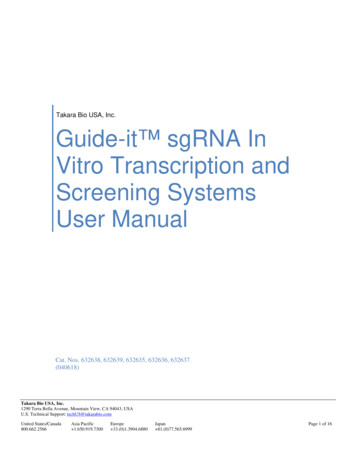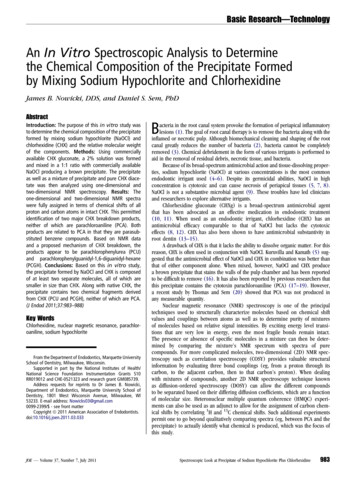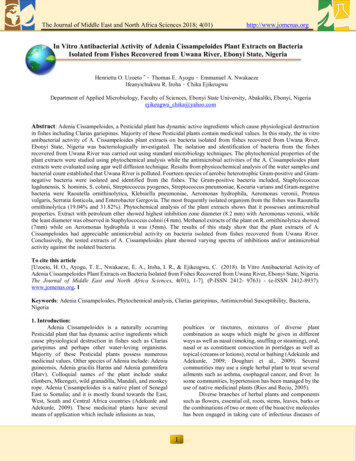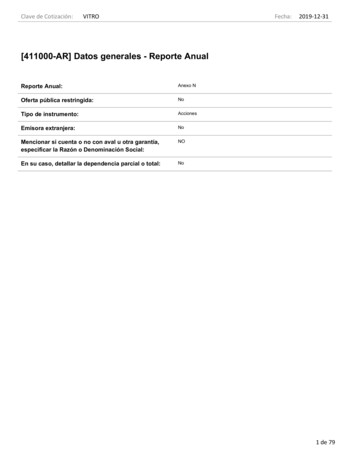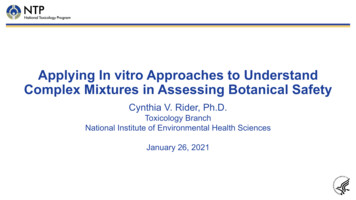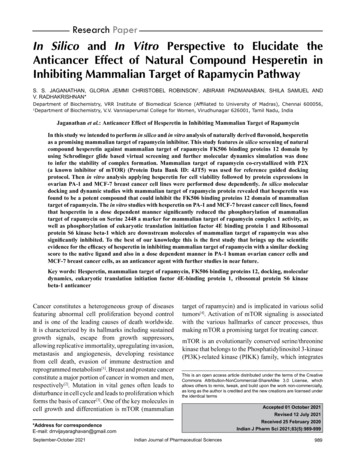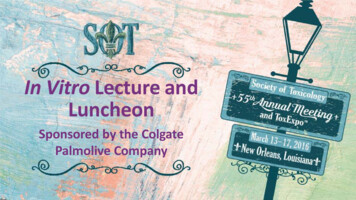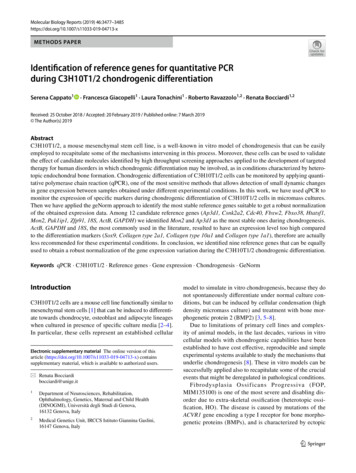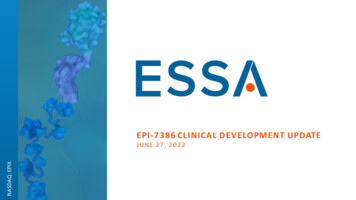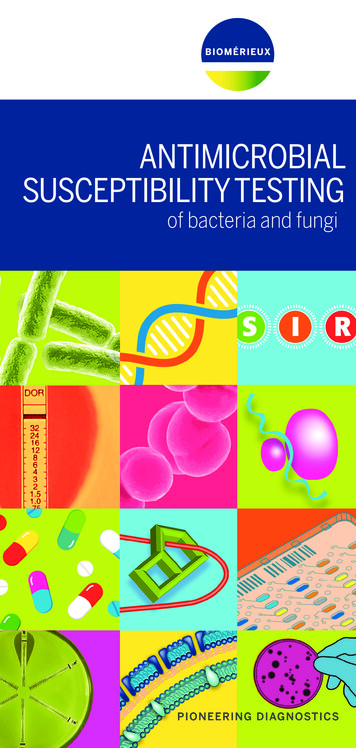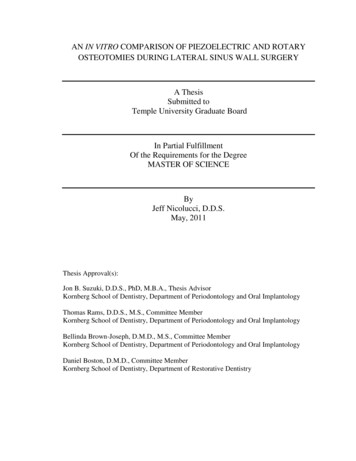
Transcription
AN IN VITRO COMPARISON OF PIEZOELECTRIC AND ROTARYOSTEOTOMIES DURING LATERAL SINUS WALL SURGERYA ThesisSubmitted toTemple University Graduate BoardIn Partial FulfillmentOf the Requirements for the DegreeMASTER OF SCIENCEByJeff Nicolucci, D.D.S.May, 2011Thesis Approval(s):Jon B. Suzuki, D.D.S., PhD, M.B.A., Thesis AdvisorKornberg School of Dentistry, Department of Periodontology and Oral ImplantologyThomas Rams, D.D.S., M.S., Committee MemberKornberg School of Dentistry, Department of Periodontology and Oral ImplantologyBellinda Brown-Joseph, D.M.D., M.S., Committee MemberKornberg School of Dentistry, Department of Periodontology and Oral ImplantologyDaniel Boston, D.M.D., Committee MemberKornberg School of Dentistry, Department of Restorative Dentistry
ABSTRACTPiezoelectric and high speed rotary instrumentation have proven to be viablemethods of preparing osteotomies during lateral sinus wall surgery. Piezoelectric unitshave been suggested to have superior access and control as well as the ability to discernbetween soft and hard tissue. The major disadvantage of the piezoelectric technology isthe reduced speed at which osteotomies are prepared. The purpose of this study was toevaluate the difference in operator perception, speed and membrane damage between thetwo modalities.Seven different operators prepared 4 osteotomies in 2 mm thick polyurethanesheets backed by 0.2 mm thick plastic wrap. The preparation speed and incidence ofmembrane damage were recorded after each osteotomy. The operator perception of eachmodality was recorded at the end of the preparations. Several questions were asked toevaluate the accuracy, visibility, vibration, comfort and ease of use of both modalities.Results showed that rotary instrumentation was 160% faster than piezo (p 0.001),but resulted in 370% more damage and 130% more perforations (p 0.01). Surveys ofoperator preference showed piezo units with higher scores for accuracy and visibility(p 0.05).This study showed that in vitro a piezo unit compared to a rotary unit results inless membrane perforation and damage, higher perception of accuracy and visibility, butlonger osteotomy preparation time.ii
ACKNOWLEDGEMENTSSpecial thanks to Dr. Suzuki and Dr. Rams for helping this thesis see fruition.iii
TABLE OF CONTENTSPageABSTRACT . . iiACKNOWLEDGEMENTS . . iiiLIST OF FIGURES . . vCHAPTER1. INTRODUCTION . . 12. METHODS AND MATERIALS . . . 53. RESULTS . .134. DISCUSSION . 175. CONCLUSION . . 21REFERENCES CITED . 22iv
LIST OF FIGURESFigurePage1. A polyurethane sheet . . .52. Front of marked and wrapped polyurethane sheet . . . 63. Back of marked and wrapped polyurethane sheet . . 74. Armamentarium . . 85. VarioSurg Ultrasonic Bone Surgery System . .96. Osteotomy preparation . .107. Magnified view of membrane damage and perforation . . 118. Cutting speed of piezoelectric versus high-speed bur .139. Average number of sites of damage and perforation usingpiezoelectric instrumentation . . . . 1410. Average number of sites of damage and perforation usingrotary instrumentation . . . . 1411. Average number of sites of damage and perforation . . 1512. Average VAS scores of operator perception on rotary andpiezo instrumentation . . . 1513. Bur and piezo osteotomies in a polyurethane sheet . . 16v
CHAPTER 1INTRODUCTIONPiezoelectric technology had its first use in dentistry described by Catuna in 1953;relating to cavity preparation. In 1955, Zinner1 used this technology to scale teeth.Piezoelectric units became more efficient and smaller but their use for bone cutting wasstill in its infancy.2,3,4,5 The first published use of a piezoelectric unit specifically forsurgical bone cutting was the Mectron, the article was published in 2000 by Vercellotti.6That led the way for other manufacturers to produce piezoelectric units and the generalacceptance of piezoelectric technology as a viable alternative to rotary instrumentationfor ostectomy, osteotomy, and osteoplasty in dentistry and in other fields.The lateral window approach to maxillary sinus augmentation is a commonprocedure in implant therapy. It was invented by Tatum,7 but first published by Boyneand James in 1980.8 The procedure augments an often deficient height of bone in theposterior maxillae due to sinus pneumatization. After or during augmentation implantsmay be inserted in the posterior maxillae to restore posterior maxillary occlusion. Thelateral window approach requires a ‘window’ to access the underlying Schneiderianmembrane. During preparation of the window inadvertent contact with the membranemay cause damage or a perforation.9 The rate of perforation has been reported to beanywhere from 10-50%.10 Classically the window osteotomy has been created usingrotary instruments. Due to the ability of piezoelectric technology to differentiate betweenmineralized and non-mineralized tissue when cutting, these units have been reported tominimize the incidence of membrane tearing to 3.6-7%.10,11 This is one possible1
advantage of piezoelectric units over rotary instruments. However, the studies showingreduced perforation rates with piezoelectric units are more recent and have the aim ofspecifically evaluating sinus perforation rates.Another significant advantage is the clearance of fluid from the surgical sitecreating more visibility for the surgeon. During lateral sinus wall surgeries this isextremely important as a perforation in the membrane can come from as much as 0.1 mmof overextension. Also aiding in the surgical visibility is the narrow diameter of some ofthe tips of piezoelectric units. Surgical ease may be increased when using piezoelectrictechnology due to the ability to use various tips of different shapes. This contrastssharply with rotary instruments which consist of circular instruments. The inferior cut atthe harvest site during ramus block grafts surgeries is significantly easier to access safelywith the reach of a 90 degree bend in the tip of the piezoelectric unit. Additionally,patient sensation of vibration is decreased when using piezoelectric units. Whencompared to rotary instrumentation, piezoelectric prepared ostectomies have been shownto result in increased viable osteocytes and less necrotic tissue.12 Moreover, someauthors13 have reported increased osteogenic and improved cytokine activity. The lastpoint is equivocal though, as the integrity of such studies have been challenged14 and areof notably of low evidence level.There are disadvantages to piezoelectric technology as well. The most publisheddisadvantage is that of time. In lateral sinus wall surgery, piezoelectric units werereported to make the entire procedure take 15% longer.15 Wisdom tooth extraction wasreported to require 35% more time when using piezoelectric units.16 However, otherswho studied the time issue found no difference in increased time when utilizing2
piezoelectric units for orthognathic surgeries.17 Another disadvantage is the acquisitionof a piezoelectric unit itself with some units costing near 8,000 USD. Tips for thepiezoelectric units last much longer than burs but are far more expensive.One must be very judicious when considering the advantages and disadvantagesof using piezoelectric technology for lateral sinus wall surgeries as the weighting forclinical practice can be quite equivocal. Probably the two most influential issues withusing piezoelectric technology for lateral wall osteotomies are that of surgical time andmembrane perforation. The effect of increased surgical time may be an increasedinfection rate and increased post-operative discomfort. The effects of membraneperforation may be decreased implant survival and increased graft infection; more sowhen the perforations are larger.18,19 Proussaefs et al. looked at 12 subjects requiringbilateral sinus augmentation and reported 33.58% bone formation for non-perforatedsinus grafts and only 14.17% bone formation for perforated sinus grafts after healing.20They also looked at implant survival and found at second-stage implant surgery the nonperforated membrane implant survival rate was 100% whereas it was only 69.6%(p 0.0028) in the perforated group. While perforation of the Schneiderian membranemay be detrimental to implant therapy, consideration should be given to the major causeof perforation. Studies10,11 have shown that perforations are most often associated withelevation of the membrane using hand instruments after initial osteotomy where thedifference between using a piezo tip or bur may have no effect. It is still plausible toachieve a decrease in membrane perforation due the use of a piezoelectric unit though, asdamage to the membrane during osteotomy preparation may not reveal itself untilelevation.3
The purpose of this study is to evaluate the differences between piezoelectric unitsand a high-speed bur in vitro with respect to operator perception, speed and membranedamage during lateral wall osteotomies.4
CHAPTER 2METHODS AND MATERIALSPolyurethane sheets (2x130x180 mm -- Sawbones Worldwide Inc.) were used tosimulate the lateral sinus wall in vitro as shown in Figure 1. The density of polyurethaneused was consistent with cortical bone lateral to the maxillary sinus (40 pcf). The sheetswere then marked with 16 20x20 mm circles as shown in Figure 2. Each sheet was sidedwith a plastic wrap (0.02 mm thick – Saran plastic wrap, a low-density polyethylene)simulating a thin Schneiderian membrane and held down via adhesive tape (3M, Scotch)as shown in Figure 3.Figure 1. A polyurethane sheet.5
Figure 2. Front of marked and wrapped polyurethane sheet.6
Figure 3. Back of marked and wrapped polyurethane sheet.7
Figure 4. Armamentarium.8
The rotary instrument used was a W&H Synea HS handpiece with a new coarseround diamond bur for each operator (Brasseler USA, 6801.31.014). The piezoelectricinstrument used was the VarioSurg Ultrasonic Bone Surgery System with a newVarioSurg SG7D round diamond tip as shown in Figure 4. The power setting of theVarioSurg Ultrasonic bone Surgery System was placed at 100% and the water setting at 2as shown in Figure 5.Figure 5. VarioSurg Ultrasonic Bone Surgery System.The sheets were positioned on two tables so that the osteotomy currently beingprepared had no table underneath (in order to properly simulate perforations). Theoperators were instructed to pay attention to accuracy, vibration, comfort, visibility, and9
ease of use during their osteotomies. The operators were also instructed that they wouldsee a blue hue simulating thin bone before osteotomy perforation and that membranedamage and perforations were being recorded and should attempt to be avoided. Sevenoperators (6 graduate periodontal residents, 1 graduate periodontal instructor) then made4 circular osteotomies each simulating a lateral window approach, following the tracedoutlines as shown in Figure 6. Osteotomies were timed by an independent observer witha stopwatch and considered complete when the polyurethane window was able to becompletely removed with minimal force. Two of each of the operator’s osteotomies weremade with a bur and the other 2 with a piezo tip for a total of 4 osteotomies per operator.Figure 6. Osteotomy preparation.10
After each operator completed their set of 4 osteotomies they were surveyed onoperator perceptions using a VAS. This included perception of accuracy, vibration,comfort, visibility, and ease of use. The plastic wrap was then cleaned and studied undermagnification to visualize and record damage and perforations as shown in Figure 7. A‘site’ was defined as the width of a bur (2 mm) around the periphery of the osteotomies.A perforation was recorded at a site if it showed any communication of air from one sideto the other. Damage was recorded at a site if the plastic wrap was altered enough tocause visible distortion of light when taut. Reproducibility measurements wereconducted by repeating damage and measurement scores 5 times for the first 4osteotomies.PerforationDamageFigure 7. Magnified view of membrane damage and perforation.11
Statistical analysis to detect statistically significant differences between the twomodalities (piezoelectric and rotary) was performed using repeated measures ANOVAfor all operators for speed, perforations and damage. A paired t-test was used to detectstatistically significant differences between the modalities on the basis of VAS ofaccuracy, vibration, comfort, visibility, and ease of use from the survey. A p-value of 0.05 was considered statistically significant.12
CHAPTER 3RESULTSThe average times for each operator to complete an osteotomy with eachinstrument is shown in Figure 8. The rotary instrumentation was significantly faster thanpiezoelectric technology. Average intra-operator osteotomy times for the piezo variedfrom 2.2-4.5 times higher than the bur. Average osteotomy times between all operatorswere 2.6 times faster when using a bur (p 0.001).1200.001000.00800.00Time 6OP7Figure 8. Cutting speed of piezoelectric versus high-speed bur.The average number of sites of perforation and membrane damage for eachoperator with each instrument is shown in Figure 9 and Figure 10. On average, rotary13
instrumentation yielded 4.7x more damage than piezoelectric instrumentation and 2.3xmore perforations (p 0.01) as shown in figure 11. The damage and perforations were100% reproducible upon 5 different re-examinations of the first 4 P3OP4OP5OP6OP7Figure 9. Average number of sites of damage and perforation using foration20OP1OP2OP3OP4OP5OP6OP7Figure 10. Average number of sites of damage and perforation using rotaryinstrumentation.14
654Sites3Damage2Perforation10PiezoBurFigure 11. Average number of sites of damage and perforation.VASs of perceptions during osteotomy preparation are shown in Figure 12.Piezoelectric instrumentation scored statistically significantly higher than rotaryinstrumentation for accuracy and visibility (p 0.05). No statistically significantdifferences were found between the two modalities on the basis of vibration, comfort orease of use (p 0.05) based on the paired fortVisibilityEase of UseFigure 12. Average VAS scores of operator perception on rotary and piezoinstrumentation.15
The bur also yielded consistently more jagged osteotomies than the piezo tips asillustrated in Figure 13.BurPiezoFigure 13. Bur and piezo osteotomies in a polyurethane sheet.16
CHAPTER 4DISCUSSIONWith the significant increases in implants being placed, sinus augmentationprocedures for deficient posterior maxillae are becoming more and more popular. Thereis a current paucity of data comparing the various instrumentation available for useduring sinus augmentation procedures.This study found high speed rotary instrumentation to be 160% faster than piezoinstrumentation for the preparation of a window osteotomy in a lateral window approachto maxillary sinus augmentation in an in vitro model. This difference is consistent withother studies15, 16 which found 15-35% longer in vivo operations considering that theosteotomy may only comprise less than a quarter of the total time required for the sinusaugmentation. This suggests the use of a piezoelectric unit for preparing maxillary sinusosteotomies will cause significantly longer surgical times than using a high speed rotaryunit.Osteotomies created via piezoelectric units had less than half the number of sitesshowing damage and/or perforation. This is also consistent with other studies11 thatshowed reduced perforation rates when using the piezoelectric unit to prepare the windowosteotomies. This study further supports the notion that piezoelectric units reduce thelikelihood of membrane damage and/or perforation compared to high speed rotaryinstrumentation. The reduction in damage and perforations may be due to thepiezoelectric technology itself or simply due to the less aggressive nature of thetechnology.17
Accuracy and visibility as judged by operator perception was statisticallysignificantly higher when using a piezoelectric unit. This is expected as the high speedbur head was close to the cutting tip often blocking view. Additionally, due to theincreased cutting speed of the bur, accuracy is expected to decrease.Polyurethane blocks were selected as the bone analog due to similar properties tonatural bone. The American Society for Testing Materials considers polyurethane astandard test for in vitro assessment of orthopedic devices.21,22 The density ofpolyurethane used was consistent with cortical bone lateral to the maxillary sinus (40pcf). The plastic-wrap (Saran – low-density polyethylene) attached to the back of thepolyurethane blocks was chosen based on its similar properties to the Schneiderianmembrane. The average Schneiderian membrane can withstand tensile forces of7.3MPa.23 Low-density polyethylene used in a plastic sheet can withstand a tensile forceof 9.9MPa.24 While this is similar, the low-density polyethylene can undergo 390%elongation compared to 132% with the average Schneiderian membrane. Still, the lowdensity polyethylene was able to easily record markings from the burs and piezo tipswhen held taut under light. For these reasons the plastic wrap was chosen as theSchneiderian membrane analog.This study chose to use a round diamond piezoelectric tip instead of a sawpiezoelectric tip. Both have been used for sinus augmentation procedures. In 2010, Sohnet al.25 showed statistically insignificant differences in perforation rates between using asaw versus round diamond piezo tip during lateral sinus wall augmentation andconcluded that the saw was a more effective tip. However, their conclusion waserroneous as they reported over 3-fold the number of perforations when using a saw tip18
compared to the round diamond tip despite statistical insignificance (p 0.26). Thissuggested that the saw tip was associated with more perforations, not a similar amount asstated in the study. Thus, in this study we decided to use the round diamond tip.A question unanswered is whether or not the difference in the damage,perforation, and accuracy is due to the difference in technology or simply due to theaggressiveness of the technology. Perhaps a less aggressive bur or slower headpiecewould yield similar results to the piezoelectric unit.There are limitations to this data. The polyurethane blocks are not identical tobone and presented more rigid fixation of the window during osteotomy than is present invivo. Thus, more aggressive osteotomies were required to complete the osteotomy andremove or elevate the window. This helps explain why this study had a much higher rateof membrane perforation than other studies.26,27 Additionally, the plastic wrap haddifferent properties than the Schneiderian membrane. The wrap had a slightly highertensile strength and was able to undergo significantly more elongation. Anotherlimitation is that the access to the osteotomy site was extremely ideal. This study failedto take into consideration the significant access difficulties associated with this procedurein vivo. Also, despite attempts to avoid this, most operators admitted that if it were a livepatient they would have likely taken more time to prepare their osteotomies due to theassociated consequences. A final limitation is that this study only examined perforationsand damage created during osteotomies. Studies10,11 have shown minimal perforationrates during the osteotomy stage of the lateral sinus lift procedure. Most perforationsoccurred on during lifting with hand instruments and were associated with either a verythin membrane or a septum. However, it is possible that method in which the19
osteotomies were prepared may affect the tear rate during lifting due to membranedamage.Future research should be directed at completing in vivo studies to see howapplicable this data is in clinical practice and how osteotomies affect overall sinusperforation rates. Additionally, future research should compare the difference betweenrotary and piezoelectric technology with equal aggressiveness to discern if the differencein results found here is due to aggressiveness or technology. A final area for futureresearch is to detail when damage and perforations occur and to isolate the temporalcauses associated.20
CHAPTER 5CONCLUSIONIn an in vitro model of lateral sinus wall osteotomies, a rotary unit with a rounddiamond bur will prepare the osteotomy 140% faster (p 0.001) when compared to apiezoelectric unit with a round diamond tip. However, the rotary unit will result in theperception of less accuracy, and visibility, (p 0.05) as well as more 370% moremembrane damage and 130% more membrane perforations (p 0.01).21
REFERENCES CITED1. Zinner DD. Recent ultrasonic dental studies, including periodontia, without theuse of an abrasive. J Dent Res 1955;34:748-749.2. Mazorow HB. Bone repair after experimental produced defects. J Oral Surg1960;18:107-115.3. McFall TA, Yamane GM, Burnett GW. Comparison of the cutting effect on boneof an ultrasonic cutting device and rotary burs. J Oral Surg 1961;19:200-209.4. Horton JE, Tarpley TM Jr, Wood LD. The healing of surgial defects in alveolarbone produced with ultrasonic instrumentation, chisel and rotary bur. Oral SurgOral Med Oral Pathol 1975;39:536-546.5. Horton JE, Tarpley TM Jr, Jacoway JR. Clinical applications of ultrasonicinstrumentation in the surgical removal of bone. Oral Surg Oral Med Oral Pathol1981;51:236-242.6. Vercellotti T. Piezoelectric surgery in implantology: A case report: A newpiezoelectric expansion technique. Int J Periodont Restorat Dent 2000;20:359.7. Tatum O.H. Maxillary and sinus implant reconstructions. Dent Clin North Am1986;30:207.8. Boyne P, James RA. Grafting of the maxillary sinus with autogenous marrow andbone. J Oral Maxillofac Surg 1980;38:113.9. Vercellotti T. Technological characteristics and clinical indications ofpiezoelectric bone surgery. Minerva Stomatol 2004;53:207-214.10. Wallace SS, Mazor Z, Froum SJ, Cho SC, Tarnow DP. Schneiderian membraneperforation rate during sinus elevation using piezosurgery: Clinical results of 100consecutive cases. Int J Periodontics Restorative Dent 2007;27:413-419.11. Toscano NJ, Holtzclaw D, Rosen PS. The effect of piezoelectric use on opensinus lift perforation: A retrospective evaluation of 56 consecutively treated casesfrom private practices. J Periodontol 2010;81:167-171.12. Berengo M, Bacci C, Sartori M, Perini A, Della Barbera M, Valente M.Histomorphometric evaluation of bone grafts harvested by different methods.Minerva Stomatol 2006;55:189–198.22
13. Labanca M, Azzola F, Vinci R, Rodella LF, Piezoelectric surgery: Twenty yearsof use. Br J Oral Maxillofac Surg 2008;46:265–269.14. Pitak-Arnnop P, Hemprich A, Sader R, Dhanuthai K, Bertrand JCh, Hennig C,Herve C. An analysis of studies on piezoelectric surgery in the oral andcraniomaxillofacial region with regard to human subject protection and financialconflicts. Int J Oral Maxillofac Surg 2009;38:1011–1013.15. Barone A, Santini S, Marconcini S, Giacomelli L, Gherlone E, Covani U.Osteotomy and membrane elevation during the maxillary sinus augmentationprocedure. A comparative study: Piezoelectric device vs. conventional rotativeinstruments. Clin Oral Implants Res 2008;19:511–515.16. Sortino F, Pedullà E, Masoli V. The piezoelectric and rotatory osteotomytechnique in impacted third molar surgery: Comparison of postoperative recovery.J Oral Maxillofac Surg 2008;66:2444-2448.17. Landes CA, Stübinger S, Rieger J, Williger B, Linh Ha TK, Sader R. Criticalevaluation of piezoelectric osteotomy in orthognathic surgery: Operativetechnique, blood loss, time requirement, nerve and vessel integrity. J OralMaxillofac Surg 2008;66:657-674.18. Hernández-Alfaro F, Torradeflot MM, Marti C. Prevalence and management ofSchneiderian membrane perforations during sinus-lift procedures. Clin OralImplants Res 2008;19:91-98.19. Oh E, Kraut R. Effect of sinus membrane perforation on dental implantintegration: A retrospective study on 128 patients. Implant Dentistry 2011;20:1319.20. Proussaefs P, Lozada J, Kim J, Rohrer M. Repair of the perforated sinusmembrane with a resorbable collagen membrane: A human study. Int J OralMaxillofac Implants 2004;19:413-420.21. Sunit P, Mahon A, Green S, McMurtry I, Port A. A biomechanical studycomparing a raft of 3.5 mm cortical screws with 6.5 mm cancellous screws indepressed tibial plateau fractures. Knee 2006;13:231-235.22. American Society for Testing Materials. Standard specifications for rigidpolyurethane foam for use as a standards material for testing orthopedic devicesand instruments. Report: F1839-97. http://www.astm.org. Accessed April 2010.23. Pommer B, Unger E, Sütö D, Hack N, Watzek G. Mechanical properties of theSchneiderian membrane in vitro. Clin Oral Implants Res 2009;20:633-637.23
24. Barr KR. Modern Plastics International. New York, N.Y.: McGraw Hill,1980;30.25. Sohn DS, Moon JW, Lee HW, Choi BJ, Shin IH. Comparison of two piezoelectriccutting inserts for lateral bony window osteotomy: a retrospective study of 127consecutive sites. Int J Oral Maxillofac Implants 2010;25:571-576.26. Wallace SS, Froum SJ. Effect of maxillary sinus augmentation on the survival ofendosseous dental implants. A systematic review. Ann Periodontol 2003;8:328343.27. Schwartz-Arad D, Herzberg R, Dolev E. The prevalence of surgical complicationsof the sinus graft procedure and their impact on implant survival. J Periodontol2004;75:511-516.24
procedure in implant therapy. It was invented by Tatum,7 but first published by Boyne and James in 1980.8 The procedure augments an often deficient height of bone in the posterior maxillae due to sinus pneumatization. After or during augmentation implants may be inserted in the posterior maxillae to restore posterior maxillary occlusion. The
